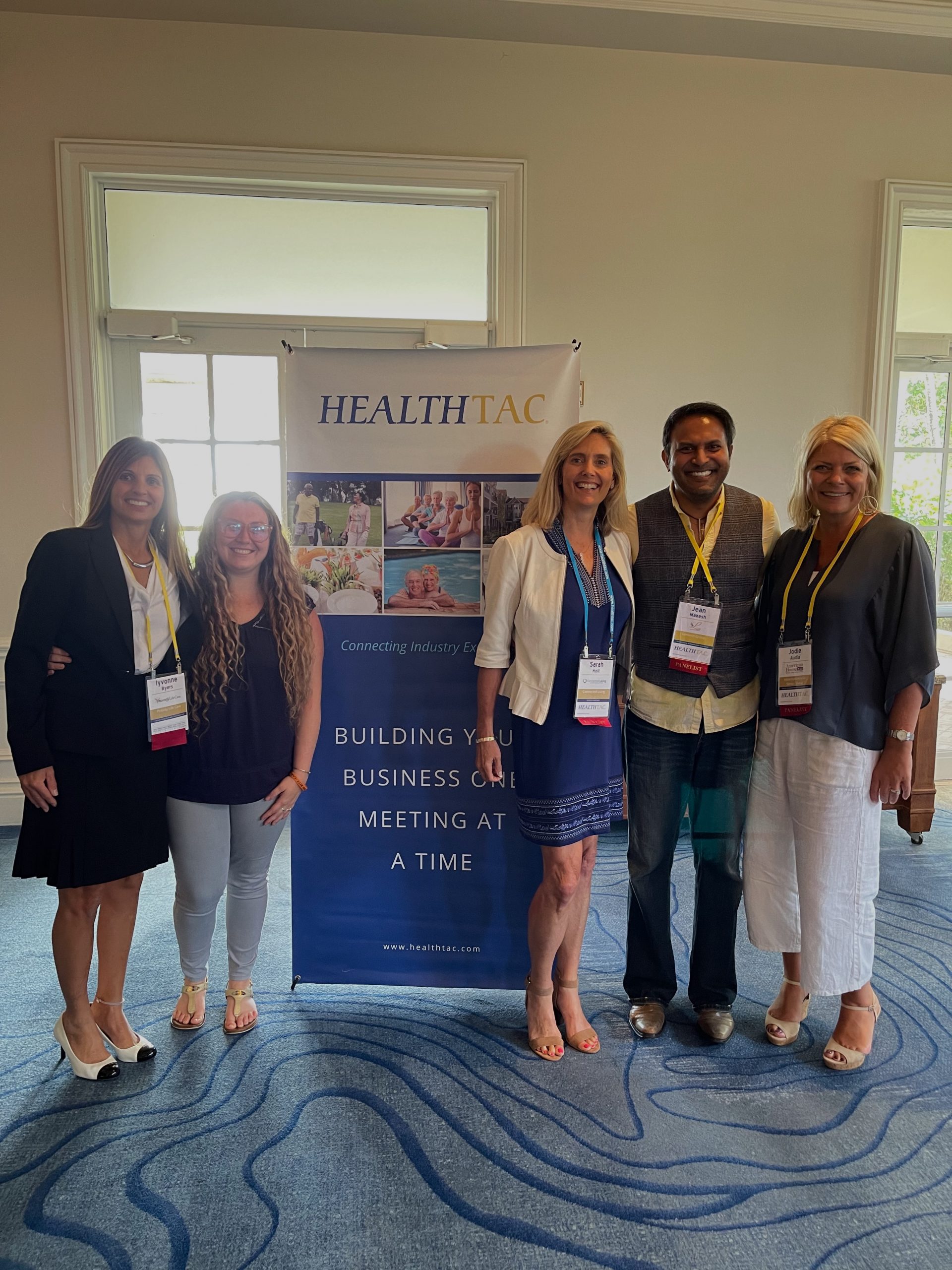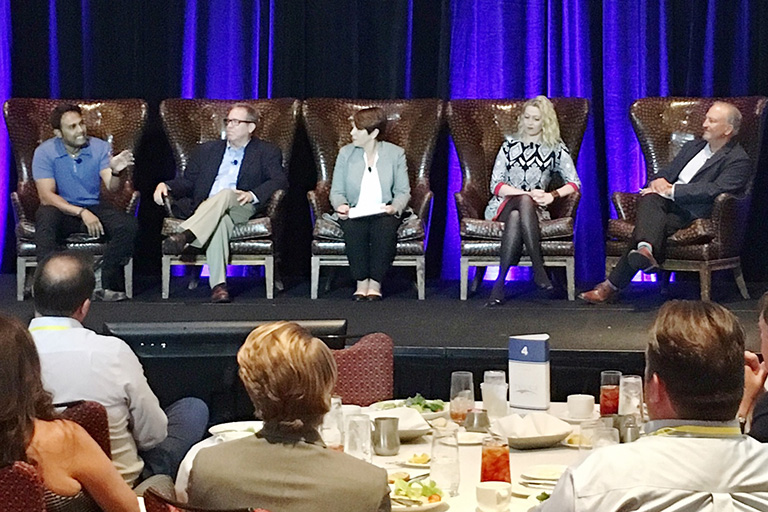
HEALTHTAC Food & Beverage Panel: The Past, Present, and Future of Senior Living Food & Beverage
By Jim Nelson | December 15, 2023

ORLANDO, FL — Charles Kettering, the 20th-century engineer and inventor who founded Delco Electronics, once famously said, “The world hates change. Yet, it’s the only thing that’s ever brought progress.” Change can certainly be uncomfortable, but it’s not only inevitable, it’s necessary.
Change was the overarching theme of The Past, Present, and Future of Senior Living Food & Beverage panel at the recent 2023 HEALTHTAC Food & Beverage conference at Disney’s Grand Floridian Hotel & Spa. The session gathered four senior living culinary department heads and a pair of food & beverage suppliers for an in-depth discussion about the changes we’ve seen, and will see, in the food and beverage side of senior living.
The conversation got started with some panelists reminiscing about things that they’re happy to no longer see in their kitchens.
“The salad station in the middle of the dining room,” Retirement Unlimited, Inc. VP of Culinary Operations Mohamed Tarawneh began, “I’m glad that thing is gone now.”
“I would say the amount of paperwork we had to manage 10 years ago,” Health Dimensions Group VP of Culinary Excellence Mika Stevenson added. “With POSs — point of care systems — we’re able to digitize a lot of that. And I think that’s been incredibly helpful.”
CareOne SVP of Culinary Services & Procurement Logistics Michael Spector was happy to see the “shift from pencil and paper to technology.”
For RiverSpring Living’s Vice President of Dining Services Shane Kuhnen, it was the transition away from RTU items. “Predominantly in the past, they used the ready-to-use products, and now we have a more fresh-food focus towards senior health.”
Bringing the conversation into the present, the panelists were asked to talk about how they are offsetting inflation.
“It’s been very important to find the pennies wherever you can,” said Kuhnen. “You could do that fillet once a week, but then you need to get a little bit more creative with grain bowls, and stuff like that, during the week.”
“We’re doing disaster menus,” said Jo Miller, the vice president of nutrition at Meals for All, “so we work with our partners to forecast into the future so that we can try and purchase things out of volume to help manage that cost over time and purchase things with a lot of forethought. The challenge is we can’t just change our menus, so we have to think to the future rather than thinking in the now.”
“As costs have risen across the board for everything everybody’s buying,” said ClarkPro Partnership Development Manager Becky Smith, “I think our options and choices are more important. Where we used to be so specific to a brand, to a certain way of doing things, I’ve seen our partners open their minds to the ‘good, better, best’ mentality, making the right choice for the operation, over sticking with what they’ve always done. If we always do what we’ve always done, we’re always going to get what we’ve always got.”
“Everybody — operators and vendors — have had to be really magicians in how they’ve adjusted over the last few years to make do,” CareOne’s Spector added.
What about new gadgets or technology currently helping to make life in the culinary department easier?
“Technology has been the best use of people’s time and energy,” said Spector. “Using a menu and production system would be a gadget accessible to staff by their mobile phones if they want, or a tablet in the kitchen. Those sorts of pieces have become invaluable in the operation today.”
“You think about all the stuff you have to manage,” Stevenson agreed: “temp logs, cleaning checklists, diet rosters, things like that. Now we have an iPad where we can do all that stuff; if you need to present something to a state inspector, or you’re doing an internal inspection, you just run a report right off the iPad. And it also sets a reminder; the chef gets an alert to go make sure that temperature’s taken.”
In The Bronx, RiverSpring’s Kuhnen is doing something unique with purées, which they call Tasteful Textures.
“I’m very proud of taking care of memory care residents,” he said. “I think everybody in this room can relate to a loved one or someone you know that went through memory impairment, and we’ve created a program that gives them the same dignified menu that our IL residents receive. So that same fillet, we do a piping and molding on campus where we present the food incredibly well. We had a resident’s daughter come in and she was, ‘My mom can’t eat regular, she’s on a purée.’ [It was] right after we kicked off the program. We said, ‘That’s a purée,’ and she burst into tears. At that moment I was like, ‘Alright, we’ve got purpose, we’re going to drive this with everything we’ve got.’
The future, of course, also includes the people who will one day work in senior living dining, so the panel was asked what they would say to a chef who’s thinking of transitioning from restaurants or the hospitality industry.
“The senior living environment is morphing into cook-to-serve, much more restaurant-style service,” Spector noted, “and my sell to somebody outside of senior living is the hours are manageable. You have time to share and spend with your family and friends.”
More than a decade ago Tarawneh was one who transitioned from restaurants to senior living. “The only thing I could advise each chef,” he offered, “it’s an opportunity to develop your skill and be better at what you do. Because in this industry we have the kitchen to ourselves, we could experiment on new recipes; in the restaurant lifestyle, you can’t do that. It’s all about revenue, and a really tight budget. The owner would be like, ‘You used my flour.’ But in senior living, you could really experiment on a new recipe and develop new skills for it. I was not a pastry chef before; I knew some, but I really developed so many recipes from scratch when I started with senior living lifestyles.”
And after working at some high-end restaurants as a sous chef, Stevenson received some great advice of his own about making the transition to senior living. “You’re not cooking for you,” he relayed. “This isn’t a restaurant. You’re cooking for these residents, this is their home, check your ego at the door and cook the food that they want. And I took that to heart.”
“I think we’re in a real fun time right now with our business,” Kuhnen said. “The innovation that’s coming up, the young minds that are getting into this industry, it’s a really exciting time. I think you’re going to see a trend in the next five to 10 years [that’s] going to really blow everybody away in the industry: those YouTube videos, those TikTok videos, you have a lot of young chefs out there that are so talented, 15, 16 years old, and they’re doing Beef Wellingtons. These guys at 25 are going to be pretty sharp. I look forward to watching it all blossom.”
And what would these captains of culinary services like to see in their kitchens in the future?
“More staff, actually,” said Tarawneh. “I think we’re all struggling in that.”
“I think with the new generation coming in, standards are going to be higher,” said Stevenson, “so we’re going to need quality to increase. To what Mohamed said, I think we’re going to have to bring in higher-skilled people, or bring in more staff, and I think that’s going to force us to move culinary-wise into a better direction in our communities.
“And server robots,” Stevenson added.
“I think in my 30 years a lot has changed,” Spector said, “but a lot really hasn’t changed. We’re all looking at different levels of technology, whether it’s turbo chef; there’s cook/chill technology; there’s combi technology; ways for us to enhance and be more efficient in how we do things.
“We did have a good discussion about robots,” he continued. “I had a really fun discussion with my table mate this morning about it, and I was able to pick his brain and sort of get an understanding of what he likes about it.”
“I think we’re going to continue to see innovations in virtual reality, augmented reality,” Smith said. “If I want to change my China pattern or my flatware pattern — I don’t know if you’ve all done this, but I do it all the time when I’m shopping on Wayfair: ‘What’s that lamp look like in that corner? What does that place setting look like?’ Right before you’re buying it. So, I think those innovations are right around the corner, and it’s going to help you make decisions quicker and make it easier to purchase.”
“One of the things that I see in the future is more use of 3D printing,” Miller mentioned. “I don’t think that we’re going to get a 3D printed pizza, per se, but maybe our garden chips are interesting ways to utilize that technology and utilize purées and things that you’re doing that could maybe enhance senior dining even more. Could you imagine a 3D printed steak for your purée residents?”
“I think you’re going to see seniors start aging more gracefully,” Kuhnen said. “We’re starting to see 90-year-olds out swimming, walking; you’re going to start seeing that number get higher and people be healthier, longer, because of education, modern-day technology for the doctors. It’s going to be a really interesting thing when we’re serving 110-, 112-year-old residents in our dining rooms. It’s going to be pretty crazy, I think.”





